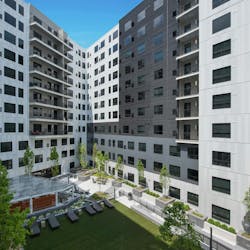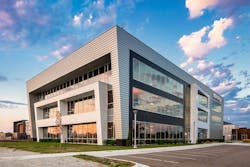Metal wall panel systems are often specified for commercial buildings, thanks to their strength and durability, but these construction mainstays are anything but basic. Today’s architectural metal panels provide endless design options, offer color coatings that stand up to harsh weather and reduce the project’s carbon footprint. Specifying PAC-CLAD metal cladding products can result in LEED credits and other environmental benefits. Additionally, they are affordable and easy to install, keeping projects on budget and on time.
For both SkyVue Apartments and Wichita State University’s Innovation Campus, architectural metal cladding provided color and texture for a modern feel, while keeping the bottom line healthy and completion on schedule.
A Switch to Metal Wall Panels Saves the Budget and Saves Time
Niles Bolton Associates in Alexandria, originally specified aluminum composite material for the exterior of the 14-story luxury SkyVue Apartments in Pittsburgh. When the ACM panels were ruled out through value engineering, PAC-CLAD products were brought in as an affordable choice with a high-end look, opting for a mix of flush and corrugated panels with trim formed from flat sheet. A color palette of white, gray and black offers a sophisticated look that fits nicely in the Oakland district of Pittsburgh, touted as the city’s academic and healthcare center, as well as a major cultural area. In addition to the varied colors, corrugated panels add texture to the façade of the large building.
“We specified the Petersen profiles for the modular construction that was planned,” said Nick Hill, project manager for Niles Bolton. “Panelizing is definitely the way to go to avoid issues with the weather. Installing vertically was more challenging than installing them horizontally, but still, it was a relatively straightforward job. The Matte Black corrugated provided a nice accent to the other colors.”
In all, 100,000 sq. ft. of PAC-CLAD Flush panels were specified in Bone White, Stone White and Charcoal. An additional 13,000 sq. ft. of PAC-CLAD 7/8” Corrugated panels in Matte Black and 28,000 sq. ft. of Flat Sheet for trim were also used on the project.
The prefabricated structural system was constructed by Wyatt Inc. in Pittsburgh. “We were brought in late to the process after the ACM had been value engineered out,” said Jim Barca, operations manager for Wyatt. “We built the whole wall system in the shop and attached the Flush Panels there, and then transported the sections to the site. The flush panels were easy to install.”
Barca added, “We were really under the gun because of the late start, and the guys at Petersen’s nearby Annapolis Junction plant really helped us out. It was a big job that really turned out nice.” The PAC-CLAD Flush Panels were fabricated at Petersen’s facility in Annapolis Junction, Md.
Mixing metal panels allows Witchita State Partnership Building 3 to have a unique identity while still fitting in with other buildings on the campus. Photo: alanblakely.com
Sustainable Metal Design for an Innovation Campus
What was once Wichita State University’s golf course is now the “Innovation Campus”: a magnet for technology and manufacturing R&D leaders. Companies like Airbus and technology services provider NetApp incubate new ideas on the campus while providing internship and job opportunities for Wichita State students. One of the latest additions to the Innovation Campus is Partnership Building 3, which features a contemporary metal-clad façade that incorporates three different panel profiles into one coherent design.
The 120-acre Innovation Campus was the brainchild of former university president John Bardo, who sought to bring corporate innovation to campus and provide new opportunities to students. Over the years, the development has grown to include multiple partnership buildings. The consulting firm Deloitte recently announced it would be working with the university to develop a “smart” factory on the campus to explore new manufacturing technologies.
Local firm GLMV Architecture, which designed Partnership Building 3, helped lead the campus’s master-planning effort and led design on several buildings in the development. Matt Cortez, AIA, president of GLMV and a lead designer on the project, said the choice to use metal panels was an easy one – it’s a common façade element throughout the new campus. But, he added, the three-profile approach helped ensure this structure also stands on its own. “We wanted to make sure all the buildings talk to each other, but we wanted them to also have their own identities.”
GLMV opted for Petersen’s PAC-CLAD line for all the panels in this project, based on suggestions from the installing contractor, Mahaney Group Inc., also based in Wichita, which had worked on other buildings on the campus. The exterior of Partnership Building 3 features 12,000 sq. ft. of Precision Series Highline S1 panels in Silver, 8,500 sq. ft. of Flat Sheet in Matte Black (used to create flat panels around window areas), and 2,200 sq. ft. of Snap-On Standing Seam panels in Bone White (highlighting the building’s main entrance, as well as window areas on the side elevations). While Snap-On panels are typically used for roofing, they can also be used for wall cladding, as in this application.
Kyle Harryman, Mahaney’s vice president for metals, said previous buildings used products from other manufacturers, but they are now opting for Petersen. “Partnership Building 3, Partnership Building 7 and a few more upcoming buildings will be based around PAC-CLAD.”
Architect Cortez added that the range of available PAC-CLAD profiles helped his team create an eye-catching design that also met the budget. “We are trying to accommodate lease rates that are manageable – to do that, we’ve got to be creative and give the best bang for the buck,” he explained.
The multi-profile design posed some challenges for Harryman’s team of installation pros. “It was fairly unusual, especially when all three profiles can “touch” at some point – it makes the detailing very difficult and time-consuming.” He added that time constraints added to the job’s pressures. “Scheduling was tough because we were tasked with completing the entire scope within two months,” he said. “It took us two-and-a-half to three months, but that’s still a pretty amazing accomplishment for that large and detailed of a project.” Harryman added that he’s now sold on using Petersen as a supplier, going forward, thanks especially to the company’s customer focus. “We have done a few jobs and I have liked everything about them, from the customer rep, Scott Craig, to the salesman, Dan Sudkamp. They’ve definitely made us a loyal partner.”
For more information on metal wall panel systems, visit PAC-CLAD.


